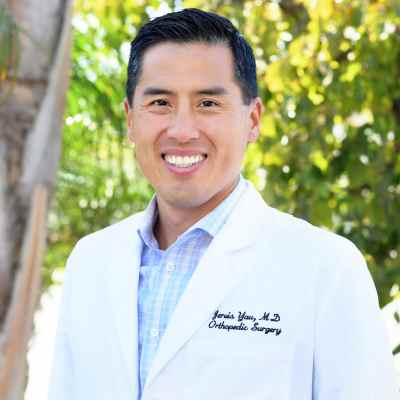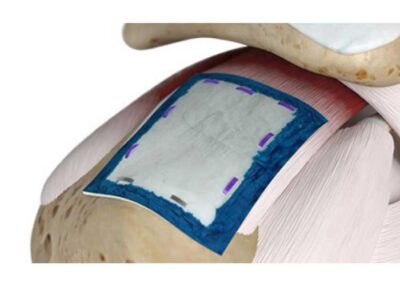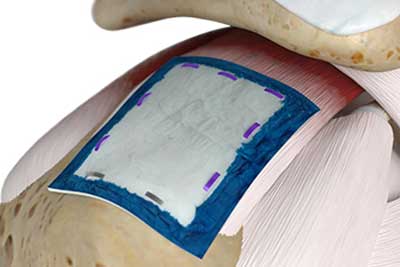Rotator Cuff Surgeon

Are you an athlete who participates in sports that involve throwing overhead? If so, you may be at risk of developing a rotator cuff injury. The rotator cuff can become damaged from repetitive overuse, a sports injury, a fall or degeneration of one of the tendons. Rotator cuff surgeon, Dr. Jervis Yau provides diagnosis and both surgical and nonsurgical treatment options for patients in Santa Barbara who have developed a rotator cuff injury. Contact Dr. Yau’s team today!
What is a torn rotator cuff or a rotator cuff injury?
Rotator cuff injuries, or a torn rotator cuff, are fairly common in the athletic community. An injury to the rotator cuff occurs when one or more of the four muscle-tendon units become damaged from an injury, fall or another traumatic event. When one or more of these tendons become torn, the shoulder loses stability, strength and range of motion. Dr. Jervis Yau, orthopedic shoulder surgeon in the Santa Barbara, Goleta, Santa Maria and Ventura, California area, specializes in non-surgical and surgical treatment of rotator cuff injuries. He will diagnose the injury and determine if arthroscopic rotator cuff repair surgery is necessary.
What types of rotator cuff injuries occur?
There are a variety of injuries that can occur to the muscle-tendon units that compose the rotator cuff. Certain patients may experience small, “micro” damage from repetitive overuse, inflammation and impingement (pinching). Other patients may experience a complete rupture of a tendon from its attachment site on the humerus (upper arm bone). When a rotator cuff tear occurs, arthroscopic surgery is typically necessary to restore mobility and strength to the shoulder joint.
What is the difference between shoulder impingement and a rotator cuff tear?
The rotator cuff is a common area for shoulder pain, especially among athletes. Shoulder impingement is sometimes called rotator cuff tendinitis can occur when the space between the acromion and rotator cuff narrows. The acromion (highest part of the shoulder) can rub against the tendon and the bursa, causing irritation and pain. A rotator cuff tear occurs when one or more of the muscle-tendon units in the shoulder become damaged and pull away from their attachment site.
How do you fix a rotator cuff tear?
Mild cases of a rotator cuff injury, such as tendonitis or shoulder impingement, are treated with activity modification, ice, anti-inflammatory medications and physical therapy to alleviate symptoms and facilitate healing.
If a partial tear of the rotator cuff has occurred, it may be helped with an innovative treatment option called REGENETEN, a Bioinductive Implant that is an advanced healing solution for biological enhancement and tendon regeneration across all rotator cuff tear types. The postage-stamp sized collagen implant offers a faster recovery and a higher repair strength of the rotator cuff. You can learn more about the REGENETEN Bioinductive Implant HERE.

REGENETEN Bioinductive Implant
What is arthroscopic rotator cuff surgery?
Shoulder arthroscopy rotator cuff surgery may be recommended by Dr. Yau if conservative measures fail or if the patient has a high-grade partial thickness or full thickness rotator cuff tear. Dr. Yau performs rotator cuff repairs utilizing minimally invasive surgical techniques to help patients return to activities quicker and with less pain.
During arthroscopic rotator cuff surgery, Dr. Yau will identify the tear and reattach it to its attachment site on the humerus. The repair is done through use of special suture anchors that are anchored within the bone. These anchors are attached to sutures that are used to sew the torn tendons back down to its attachment site on the bone. If necessary, Dr. Yau will perform a double row repair to add stability to the repair site. This technique consists of two rows of anchors in the bone with sutures in between to secure the torn tendon back to its original attachment site.
Recovery and Rehabilitation Following Arthroscopic Rotator Cuff Surgery
After shoulder surgery, patients will be placed in a sling or similar device to prevent movement of the repaired joint in order to facilitate healthy healing. Dr. Yau will prescribe a physical therapy program following the procedure to restore function and limit stiffness. The progression of the program will vary from patient to patient depending on injury severity and type of surgery performed. Patients can expect a steady progression through range of motion and strengthening exercises with a gradual return to normal activities. Rotator cuff repairs generally take approximately 6 to 9 months to fully recover with some patients taking even longer.
For additional information on arthroscopic rotator cuff surgery, REGENETEN, or to learn more about which type of surgical options are right for you, please contact the office of Dr. Jervis Yau, orthopedic shoulder surgeon in the Santa Barbara, Goleta, Santa Maria and Ventura, California area.
Rotator Cuff Surgery FAQ
1. Can a rotator cuff heal on its own?
Even though most rotator cuff tears cannot heal on their own, return of function can be achieved without surgery. The goal of non-operative treatment is to relieve pain and restore strength. In cases of a low-grade partial rotator cuff tear, patients can use non-operative measures such as rest, ice, anti-inflammatory medication and physical therapy. If patients are active and use the arm for overhead work or sports, then surgery is typically recommended to repair the rotator cuff tear back to full function
2. How is rotator cuff surgery performed?
During arthroscopic rotator cuff surgery, Dr. Yau will identify the rotator cuff tear and reattach it to its attachment site on the humerus. The repair is done through use of special suture anchors that are placed within the bone. These anchors are attached to sutures that are used to sew the torn tendons back down to its attachment site on the bone.
If necessary, Dr. Yau will perform a double row repair to add stability to the injury. This technique consists of two rows of anchors in the bone with sutures in between to secure the torn tendon back to its original attachment site.
3. How long does it take t0 perform rotator cuff surgery?
The complexity of the rotator cuff injury will determine surgery time. In most cases, a rotator cuff repair is about an hour in length. Almost all patients return home the same day as the procedure.
4. How long does it take for a rotator cuff to heal? What is rotator cuff healing time?
After shoulder surgery, patients will be placed in a sling or similar device to prevent movement of the repaired joint in order to facilitate healthy healing. Rotator cuff repairs typically take 6 to 9 months to fully recover with some patients taking longer.
5. What are rotator cuff injury exercises?
Dr. Yau will prescribe a physical therapy program following the procedure to restore function and limit stiffness. The progression of the program will vary from patient to patient depending on injury severity and type of surgery performed. Patients can expect a steady progression through range of motion and strengthening exercises with a gradual return to normal activities.
6. Why do I have continued pain after rotator cuff surgery?
A period is required for the shoulder to recover. When physical therapy is not properly completed, the shoulder can become stiff due to lack of movement, which causes pain.
Shoulder pain that never improved after rotator cuff surgery can be caused by an incorrect diagnosis, perioperative rotator cuff failure or post-operative adhesive capsulitis. When patients experience an improvement in symptoms, followed by a sudden onset of pain, an acute re-tear of the rotator cuff can be the cause. Similarly, patients who experience improvement in symptoms followed by gradual onset of pain can be caused by a chronic re-tear. A complete evaluation by an orthopedic surgeon is needed to determine the exact cause of pain.
7. Why have a second rotator cuff surgery?
When a rotator cuff re-tear occurs, Dr. Yau generally recommends a revision rotator cuff surgery to ensure a proper recovery. A second rotator cuff surgery is a more difficult procedure to perform, which is why it is very important to have a skilled orthopedic surgeon to perform the revision. During a revision surgery, Dr. Yau identifies the healthy tendon and reattaches to its anatomic attachment site.
In the case of ‘irreparable’ rotator cuff tears, patients may need to consider other options. Sometimes Dr. Yau will recommend a fairly new procedure known as superior capsular reconstruction. Introduced in 2007, this procedure was designed for patients with irreparable rotator cuff tears where shoulder arthritis is present. The goal of superior capsular reconstruction is to reconstruct the superior capsule, upper part of the shoulder joint’s lining, through the use of a dermal patch. Utilizing an arthroscopic approach, Dr. Yau attaches the dermal patch to the humeral head on one side, as well as to the rotator cuff tendons in the front and back. Superior capsular reconstruction has been effective at restoring mobility and improving function to patients with irreparable rotator cuff tears.
8. How easy is it to re-tear your rotator cuff after surgery?
When initial treatment of a rotator cuff tear has been properly performed by an orthopedic surgeon and patients follow post-operative guidelines, it is difficult to re-tear the rotator cuff. A re-tear can be caused by a traumatic fall, returning to activities too soon, failure of the tendon healing back to the bone, or overuse.
9. What are symptoms of a re-tear following rotator cuff surgery?
Symptoms of a re-tear following a rotator cuff repair can include pain over the top of the shoulder joint, weakness and tenderness, and limited range of motion. Patients can also have trouble sleeping on the affected shoulder. To be sure if there has been a re-tear of the rotator cuff, it is important to have an orthopedic surgeon give a proper diagnostic evaluation.
10. How does re-injury after rotator cuff surgery occur?
In some cases, the initial rotator cuff surgery was not properly performed causing re-injure. In cases of the treatment of large rotator cuff tears, the re-tear rate increases. Patients may re-injure the rotator cuff from a fall, going back to activities too quickly, or chronic overuse.
11. How does a rotator cuff surgery fail?
Rotator cuff surgery can fail due to a number of reasons. The initial surgery could have been incorrectly performed causing the rotator cuff tendon to improperly heal back to the bone. Patients who do not follow strict post-operative guidelines can hinder the success of a rotator cuff repair. Traumatic incidents such a sudden fall, or returning to activity too soon can cause an acute re-tear. Chronic overuse of the shoulder can also cause a rotator cuff surgery to fail.

